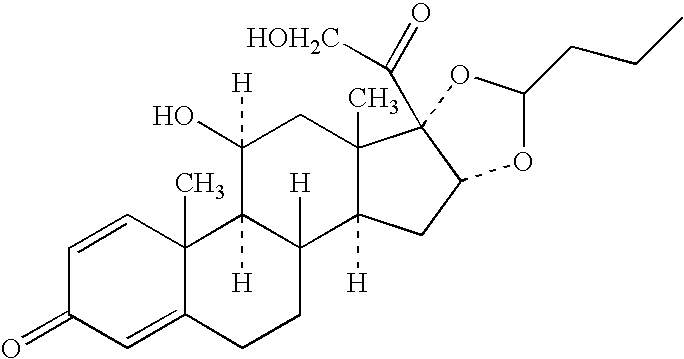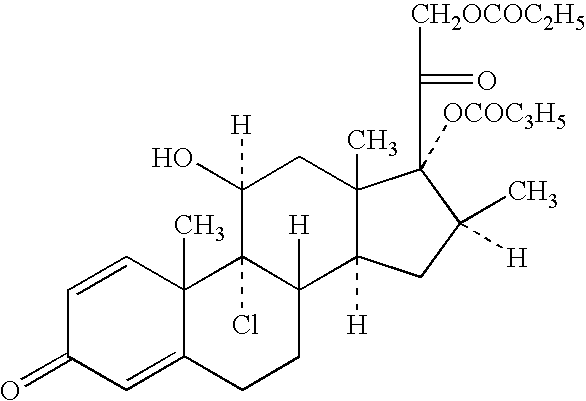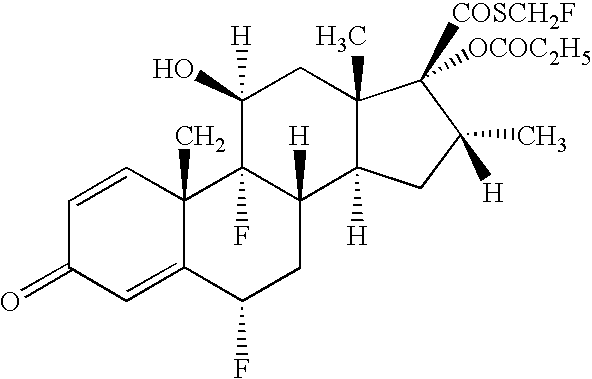Sterilized nanoparticulate glucocorticosteroid formulations
a technology of glucocorticosteroid and nanoparticulate, which is applied in the direction of drug composition, dispersed delivery, immunological disorders, etc., can solve the problems of beta and gamma irradiation, ethylene oxide is not an acceptable process for sterilization, and sterilization in the presence of water is not an acceptable method for sterilization, etc., to achieve the effect of rapid heat sterilization
- Summary
- Abstract
- Description
- Claims
- Application Information
AI Technical Summary
Benefits of technology
Problems solved by technology
Method used
Image
Examples
example 1
[0193] The purpose of this example was to evaluate the particle size of nanoparticulate dispersions of budesonide having polysorbate 80 as a nonionic surface stabilizer, both in the presence and absence of the amphiphilic lipid lecithin.
[0194] Budesonide has the following formula:
[0195] Budesonide is designated chemically as (RS)-11,16,17,21-Tetrahydroxy-pregna-1,4-diene-3,20-dione cyclic 16,17-acetal with butraldehyde. Budesonide is provided as the mixture of two epimers (22R and 22S). The empirical formula of budesonide is C25H34O6 and its molecular weight is 430.5.
[0196] Budesonide is a white to off-white odorless powder that is practically insoluble in water and in heptane, sparingly soluble in ethanol, and freely soluble in chloroform.
[0197] An aqueous colloidal dispersion (NCD) containing 30% (w / w) budesonide and 1.5% (w / w) Polysorbate-80 was prepared by adding 10 g of Polysorbate-80 to 456.7 g Sterile Water for Injection (Abbott Labs) and 200 g of budesonide (Farmabios)....
example 2
[0204] The purpose of this example was to determine the effect of different quantities of a nonionic surface stabilizer and a amphiphilic lipid on the particle size of a nanoparticulate budesonide dispersion following autoclave heat treatment.
[0205] Separate portions of the 30% budesonide, 1.5% Polysorbate-80 milled dispersion described in Example 1 were further diluted and compounded with the addition of varying levels of sterile water for injection (SWFI), Lecithin NF, and Polysorbate-80 to examine the effects of different percentages of Polysorbate-80 and Lecithin NF on budesonide particle size following autoclave heat treatment. The effects of different autoclave exposure temperatures is also illustrated in Table II (“API” is active pharmaceutical ingredient, or budesonide). All percentages in Table II are by weight.
TABLE IIParticle Size of Budesonide Dispersion Following Autoclave HeatTreatment Effect of different percentages of Polysorbate-80 and Lecithin NF15 min @ 121° C....
example 3
[0207] The purpose of this example was to determine the effect of phosphatide type on budesonide particle size following autoclave heat treatment.
[0208] An aqueous dispersion of 30% (w / w) budesonide and 1.5% (w / w) Polysorbate-80 was prepared by adding 12 g of Polysorbate-80 to 548 g Sterile Water for Injection (Abbott Labs) and 240 g of budesonide (Farmabios). The slurry was then combined with 474.3 g polyMill™-500 (Dow Inc) polymeric attrition media and charged into the 1215 mL chamber of a NanoMill®-1 milling system. The slurry was milled for 95 min. at 1200 rpm. Upon completion of the milling, the resulting nanoparticulate budesonide / polysorbate 80 dispersion was harvested through a stainless steel screen. Particle size analysis of the budesonide / polysorbate-80 dispersion, using a Horiba LA-910 particle size analyzer (Irvine, Calif.), showed a mean particle size of 197 nm, with a D50 of 185 nm and a D90 of 277 nm.
[0209] The resulting budesonide / polysorbate-80 dispersion was the...
PUM
| Property | Measurement | Unit |
|---|---|---|
| particle size | aaaaa | aaaaa |
| temperature | aaaaa | aaaaa |
| particle size | aaaaa | aaaaa |
Abstract
Description
Claims
Application Information
 Login to View More
Login to View More - R&D
- Intellectual Property
- Life Sciences
- Materials
- Tech Scout
- Unparalleled Data Quality
- Higher Quality Content
- 60% Fewer Hallucinations
Browse by: Latest US Patents, China's latest patents, Technical Efficacy Thesaurus, Application Domain, Technology Topic, Popular Technical Reports.
© 2025 PatSnap. All rights reserved.Legal|Privacy policy|Modern Slavery Act Transparency Statement|Sitemap|About US| Contact US: help@patsnap.com



